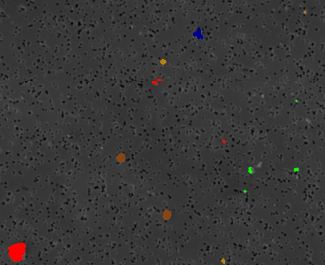新たなラマンイメージングの基準で、あらゆる方向へ研究を進めましょう
関連: 法医学・環境
サイズ、形態、組成を測定することにより、空気中の粒子の起源を決定
Historically, airborne particulates have been dealt with primarily by number and size , i.e. the numbers of particles within size ranges such as PM10 which refers to airborne particles of 10µm or less and PM2.5 for particles of 2.5µm or less. This classification lacks one particular important set of information and that is the composition of the particles. This information is starting to become increasingly valued and is likely to be even more so in the future as understanding develops on the specific effects of particles of different compositions at this size scale. SEM/EDS based automated particle analysis provides an effective way to link the size of particles to other morphological features such as shape and composition and therefore give additional information about their potential environmental and health impacts.

Particles trapped in an air filter are automatically detected and classified by their composition and size